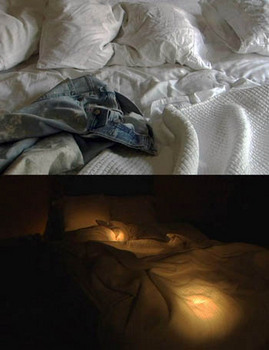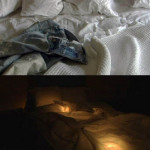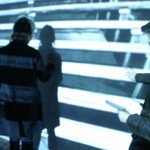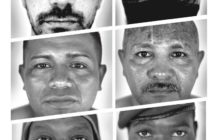By JACQUELINE HOUTON
I sit in relative comfort in the climate-controlled gallery, on the bench so thoughtfully provided for me, and yet I am profoundly uncomfortable. I am watching a body slowly tumble down a flight of stairs, shaking the wooden framework with its terrible rhythm. The body is entirely shrouded, white burial cloth tied at the neck, waist, knees, and ankles, obscuring all details of identity so that the viewer is left only with a sense of its surprisingly insistent weight, with an opportunity to study the way it falls—torso thudding against each step a half-second before the hips, the legs. And of course, with a vague sense of shame at doing so, at watching the spectacle of a violence that is simultaneously symbolic and literal, unnecessarily self-imposed yet purposeful.
This body in question belongs to artist Denise Marika, and the disturbing little drama she enacts onscreen is part of her installation,Downrush. The work is one of two on display at AXIOM Gallery’s current exhibit, Witnesses. Both attempt to interrogate indifference as they comment on our contemporary political climate.
“Downrush exposes our complicity and questions our passivity as witnesses to current events, conflicts, war, genocide, and the resultant loss of lives,” declares Marika in tje artist’s statement, suggesting that her body is being used in this bruising ritual as a surrogate for victims of real violence. And indeed, it is easy to feel complicit in something unspeakable when you watch what looks like a corpse smacking each step again and again, all the while seated on makeshift benches—the back one taller than the front, both made from weathered planks lain atop concrete blocks—that are eerily reminiscent of the wooden stairs in the video. Venture off those benches, and the paneled walls of the exhibition room reveal themselves as more than impromptu projection screens. From ceiling to floor, they are covered in Braille renderings of text from the Torah, the New Testament, and the Koran—the holy texts of three faiths whose followers worship the same God but whose disputes are the source of so much strife. The gallery staff will gladly give you a key to the Braille alphabet, but the sighted will still find themselves handicapped by a painfully slow translation process: these words of God are nearly as inaccessible to us as the images of Marika’s video would be to a blind visitor. The juxtaposition of unreadable text and indelible image begs the question: when we are passive witnesses to atrocity—a role we increasingly play, it seems, in an age where news is nearly instantaneously available on air and online—what are we seeing, and what are we not seeing?
“Salt in the Wound (The NAFTA Effect),” the second work featured in Witnesses, makes a more targeted attack on social injustice. S.A. Bachman and David John Attyah, who together form the activist art collaborative THINK AGAIN, created their three-channel video installation to critique the xenophobia they see as imbuing the immigration debate. The video shown on one of the three screens, which plays in alternating English and Spanish versions, effectively highlights the vast but often invisible impact of undocumented workers in our lives and indicts a system that rubs salt in the wound—demanding dirt cheap labor while criminalizing those who provide it. Words in red lettering appear against a background of rock salt: “TRIMMING PERFECTLY MANICURED 12-FOOT HEDGES,” “LAYING 50,000 EVENLY SPACED BATHROOM TILES,” “FOLDING 300 BANQUET NAPKIN SWANS.” These concrete and quantifiable statements, which expose the hidden cost of comforts many of us take for granted, are juxtaposed with the rewards workers earn for such labors: “TRAFFIC TICKETS THAT TRIGGER DEPORTATION,” “THE 17-YEAR PATH TO CITIZENSHIP,” “PINSTRIPED PUNDITS PEDDLING PATRIOTISM. ” Not content to limit their critique to the walls of AXIOM, Bachman and Attyah will have their words projected onto walls across the greater Boston area each night during the exhibit’s six-week run, stirring conversation at neighborhoods in Jamaica Plain, Dorchester, Lowell, and New Bedford—the site of a massive raid that led to the detention of more than 300 factory employees last March.
The message of the other two channels of “Salt in the Wound,” however, is rather less potent. One screen shows a sunlit bed with rumpled white linens; someone tosses a pair of jeans, a shirt onto the bed from offscreen, and then removes them. The other screen shows what may be the same bed by night; beams of flashlights pierce the darkness as they scan over the empty bed. Are we supposed to be moved by the fact that this bed is never slept in? Do the flashlights mimic searchlights, symbolic of border patrolling and the omnipresent threat of roundups? It never becomes clear what the artists intend the viewer to take from these twin scenes.
AXIOM’s website asserts that the artworks in Witnesses “induce the viewer to become more aware, informed, and involved.” Can such works actually spur souls to seek out information, write their congressman, donate their money and time, or even put their own bodies in harm’s way for the sake of others? It is certainly debatable whether watching an artist roll down a flight of stairs can make us care more about the fresh crop of real corpses that appears each day in Baghdad, Myanmar, and Darfur, or whether an unmade bed can teach us anything about the plight of the more than ten million undocumented workers who toil in America’s kitchens and construction sites, playrooms and salons, fields and factories. But politically engaged art is an end worth striving for, perhaps now more than ever, and there are elements in both works that give credence to the possibility that the answer is yes—that a seed may be planted amid indifference that might one day make a difference, even if only a handful of gallery-goers are affected at a time.
Witnesses is on display at AXIOM Gallery through December 1st.
All images courtesy of the artists and AXIOM Galery.
- THINK AGAIN (S.A. Bachman and David John Attyah), stills from Salt in the Wound (The NAFTA Effect), video and outdoor projections.
- Denise Marika, still from Downrush, video and Braille installation.
- Viewers come up close to Marika’s Downrush.
"Witnesses" is on view through December 1st, at Axiom Gallery, located at 141 Green Street
Jamaica Plain, MA (just off the Orange line, Green St. stop)
All images are courtesy of the artists and Axiom Gallery.
Marika image from the opening reception courtesy of Autumn Ahn.







